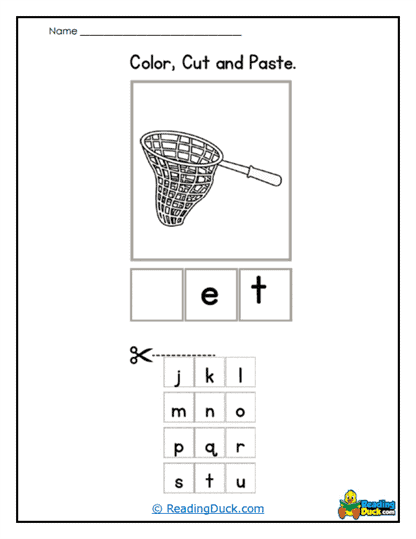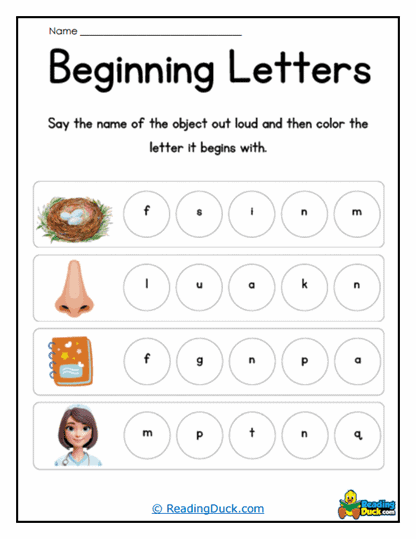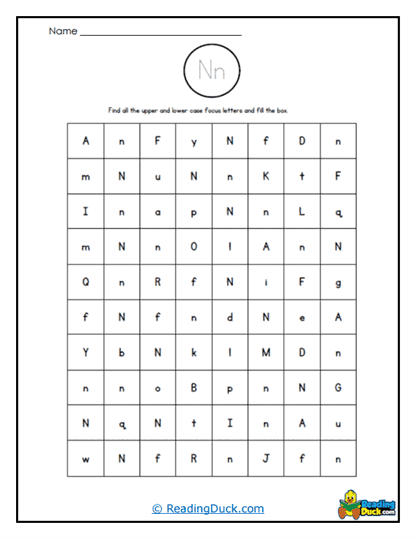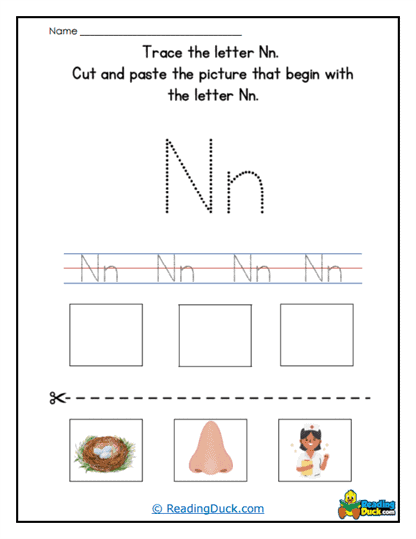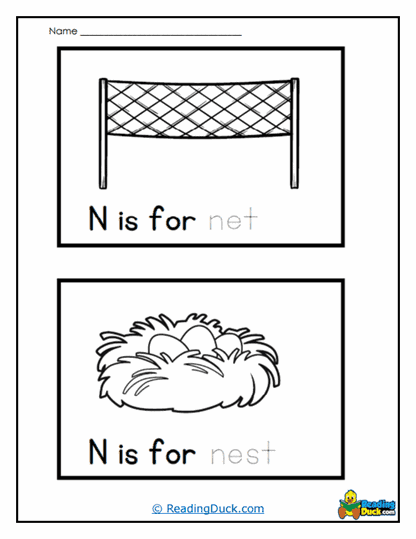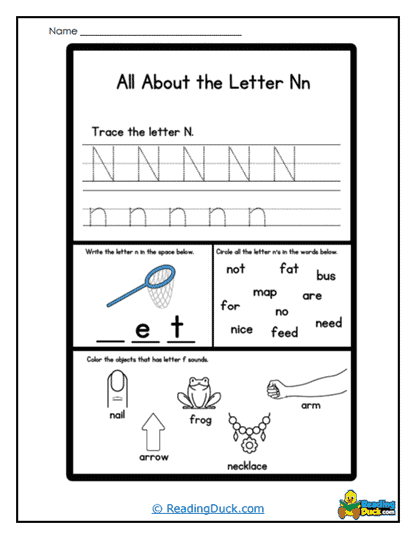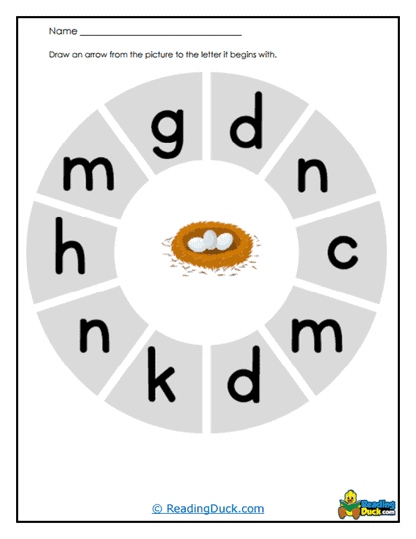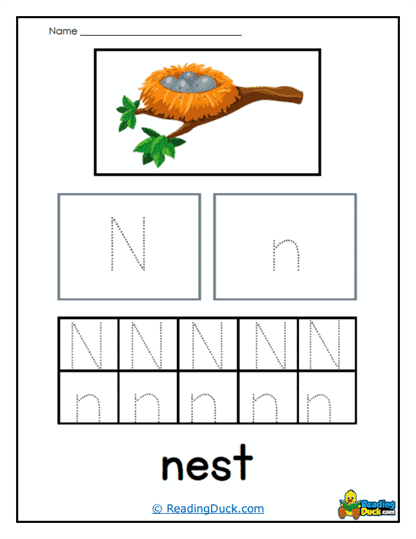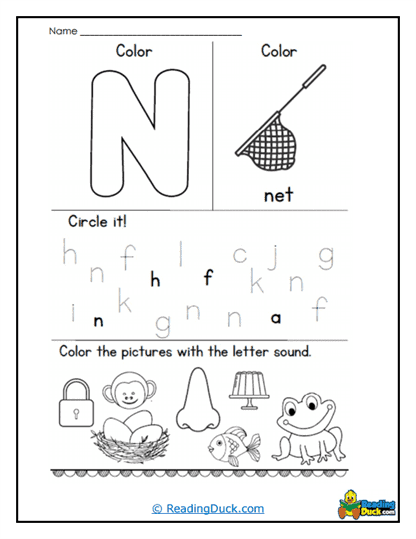Letter N Worksheets
About Our Letter N Worksheets
All worksheets in this collection contain Letter N worksheets that are visually engaging to young students. This collection includes various activities designed to improve young learners’ familiarity with the letter N in terms of reading, recognizing, and writing it. These worksheets are all readily available in PDF files, making them easy to view electronically, download, and print out for usage. An answer key is provided for every worksheet.
Understanding the Importance of the Letter N
The letter N is a foundational building block in early literacy development. It is the 14th letter in the alphabet and is crucial for students to recognize, pronounce, and write. When introducing the letter N, it is important to emphasize its role in the structure of words and its phonetic sound, which is associated with a variety of everyday words and names. Here’s how teachers might present the letter N to students:
Key Aspects of the Letter N:
- Alphabet Recognition: Understanding where the letter N fits within the sequence of the alphabet helps children build a mental map of the alphabet as a whole. This recognition is essential not only for alphabetical order but also for organizing information and locating words in a dictionary or index later on.
- Phonemic Awareness: The letter N is associated with the /n/ sound, as in words like "nest," "nose," and "night." This sound is a nasal consonant, and mastering it is key for clear speech and reading fluency. Phonemic awareness activities that involve the letter N help students break down the sounds in words, making it easier for them to blend sounds when reading.
- Visual and Shape Recognition: The shape of the letter N, both uppercase (N) and lowercase (n), is distinct and should be easily recognized by students. Learning to differentiate N from other letters, especially those with similar shapes like M or H, is critical for developing strong visual literacy skills.
- Writing Practice: Writing the letter N requires students to practice straight and diagonal lines, which are foundational strokes in handwriting. Repeated practice in writing both the uppercase and lowercase forms of N will enhance students' fine motor skills and prepare them for more complex writing tasks.
- Vocabulary Development: The letter N introduces students to a wide range of vocabulary. Words like "nut," "nail," and "noon" are simple and can be easily understood by young learners. Expanding their vocabulary with N words not only enhances their language skills but also their comprehension abilities.
- Interactive Learning: Engaging students in interactive activities that focus on the letter N can make learning more dynamic and enjoyable. For instance, students might participate in activities like identifying objects around the classroom or home that begin with the letter N, which helps reinforce their learning through real-world connections.
- Cultural and Linguistic Relevance: The letter N is also significant in learning about names, both common and proper nouns. Understanding that N can begin names like "Nancy" or "Nick" helps students connect their learning to people they know, making the learning experience more personal and memorable.
- Real-World Application: Encouraging students to find the letter N in their daily lives, whether in books, on signs, or in spoken language, helps reinforce the importance of this letter. This real-world application of classroom learning ensures that students can recognize and use the letter N outside of structured activities.
By focusing on these aspects, teachers can provide a comprehensive introduction to the letter N, setting the stage for more advanced literacy skills.
Creative Ways to Incorporate Letter N Worksheets into the Curriculum
Integrating Letter N Worksheets into Daily Learning
The Letter N worksheets can be seamlessly integrated into a variety of classroom activities. Here are some practical and creative ideas for incorporating these worksheets into your teaching:
- Morning Warm-Up Activities: Begin the day with a letter N activity to get students focused and ready for learning. This could involve a quick writing exercise, identifying N words from a list, or tracing the letter N. These activities can serve as a warm-up to more complex lessons and help reinforce the day's focus on the letter N.
- Letter of the Week Program: Dedicate a week to exploring the letter N. Throughout the week, incorporate the letter into different subjects, such as reading stories that highlight N words or using the letter N in art projects where students create items like necklaces or nature scenes. The worksheets can be used daily to reinforce the letter's recognition and writing.
- Storytime Integration: Choose books that emphasize the letter N, such as "Night-Night, Little One" or "Nancy the Nanny Goat." After reading, students can complete worksheets that focus on tracing, writing, and identifying the letter N, linking their literacy practice to the stories they enjoy.
- Alphabet Scavenger Hunts: Organize a scavenger hunt where students search for objects starting with the letter N. Afterward, they can use the worksheets to record and illustrate the words they found, further solidifying their connection to the letter N.
- Interactive Games: Create games centered around the letter N, such as matching games where students pair uppercase and lowercase Ns or sorting activities where they categorize items based on whether they start with the letter N. These games can be complemented by worksheets that allow students to practice these concepts on paper.
- Art and Craft Integration: Engage students in crafts related to the letter N. For example, they could create a necklace or a night sky scene, incorporating the letter N in their artwork. The worksheets can then be used to reinforce writing and recognizing the letter N in a fun and creative context.
- Group Activities: Set up learning stations where students rotate through different activities focused on the letter N. These stations might include writing the letter N, identifying N words in a story, or creating art projects related to the letter. Each station can use a worksheet to guide the activity and provide a record of student learning.
- Homework Assignments: Use the worksheets as homework to reinforce classroom learning. This gives students additional practice at home and allows parents to engage with their child's education, supporting their learning outside the classroom.
- Thematic Units: Incorporate the letter N into broader thematic units, such as "Nature and the Environment," "Nighttime and Daytime," or "Nutrition and Health." The worksheets can be used within these units to strengthen students' understanding of the letter N and its role in various contexts.
- Technology Integration: If digital tools are available, consider using interactive versions of the worksheets. Students can trace and write the letter N on a tablet or use educational apps that reinforce letter recognition and phonics in an engaging format.
Grade Levels That Benefit from Letter N Worksheets
These worksheets are particularly beneficial for Pre-Kindergarten, Kindergarten, and early First Grade students. They are designed to help early learners develop foundational literacy skills, with a specific focus on letter recognition, phonics, and handwriting. Additionally, English Language Learners (ELL) in the early grades may find these worksheets especially helpful as they work on building their English language skills.
Enhancing Skills with Letter N Worksheets
How Learning the Letter N Supports Overall Development
The activities in these Letter N worksheets do more than just teach students to recognize and write a single letter. They support a wide range of skills that are crucial for both academic success and personal growth:
- Fine Motor Skills: Tracing and writing the letter N helps students develop fine motor skills necessary for writing and other tasks requiring hand-eye coordination. The worksheets provide ample practice opportunities, allowing students to strengthen their hand muscles and improve their control.
- Phonemic Awareness: Understanding the sound associated with the letter N is crucial for phonemic awareness. This skill is foundational for reading and spelling, as it helps students hear, identify, and manipulate sounds within words.
- Cognitive Development: Completing the worksheets requires students to follow instructions, focus on tasks, and engage in problem-solving. These cognitive processes are vital for all areas of learning and help students develop critical thinking skills.
- Language Development: Exposure to words that begin with N, along with practicing writing and recognizing these words, helps expand students’ vocabulary. This is essential for building strong language skills and improving communication.
- Confidence Building: Successfully completing tasks related to the letter N can boost students’ confidence in their abilities. As they master the letter, they gain a sense of accomplishment that encourages them to continue learning and exploring.
- Creativity and Imagination: Incorporating creative activities into learning about the letter N, such as drawing or crafting, allows students to express themselves while reinforcing their understanding of the letter.
- Social Skills: Group activities centered around the letter N encourage collaboration, communication, and teamwork among students. These social skills are essential for building positive relationships and working effectively with others.
By incorporating these worksheets into the learning process, teachers and parents can help students build a strong foundation in literacy while also supporting their overall development. The skills gained through these activities will be valuable throughout their academic journey and beyond.
The Impact of Mastering the Letter N
Why the Letter N is Essential in Early Literacy
Mastering the letter N is a key milestone in a child’s early literacy journey. The activities in these worksheets provide young learners with the tools they need to recognize, write, and understand the letter N, laying the groundwork for future reading and writing success. Through engaging and varied practice, students not only develop essential literacy skills but also enhance their cognitive, motor, and social abilities. This comprehensive approach ensures that students are well-prepared for the challenges of learning and growing in an academic environment.
